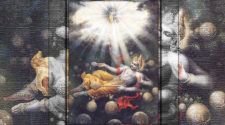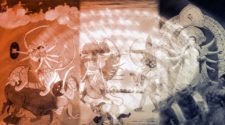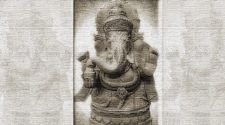In 1792 Britain had just come out of a war that had cost it not only much of its national treasury, but also one of its lucrative overseas colonies in form of North America. The empire needed new sources of revenues, new opportunities of trade and there was one clear possibility in front of them: China.
By the end of the 18th century the world had become a much smaller place, with European traders trotting the globe in an effort to feed the supply chain of raw materials and to find new markets for rapidly industrializing Europe. Wars were fought all over the world to secure exotic goods or the raw constituents needed to power the new economies of the rising superpowers. However China had still remained aloof. The demand for Chinese produce was high all over the world. Silk and Porcelain were sought-after by western buyers, but on the contrary, the Chinese emperor saw the foreign traders as a potentially destabilizing influence and had placed strict controls on foreign trade. Specifically they had limited the entire trade to just a few ports. Traders weren’t allowed to enter the empire, except for a few designated port-cities and all trade supplies had to pass through Cohong, sometimes spelled as Kehang or Gonghang. A trade monopoly system or the Guild of Chinese Merchants or Hongs, which governed the import-export in Canton (Now Guangzhou) had considered the particular mechanism fit, during the Qing dynasty (1644–1911). In the middle of the 18th century it was taken further and all trades were restricted to only one port: Canton. This drove European traders into a concerned state because they saw limitless opportunities in the Chinese market. These traders were in some ways a self-endorsing group who believed in the inherent value of unrestricted trade because they earned their livelihood by carrying tons of goods thousands of miles across the ocean. So, with more restriction came along a higher rate of piracy and smuggling. Even within official channels of trade in place, merchants began to strain at their limitations.
Eventually an employee of the East India Company, the militarized trade organization responsible for British Affairs in India, pushed by, what he saw as abuses of corrupt officials and undue restrictions on free trade and decided that it was time to openly break the rules imposed by China. He left Canton and took his grievances upriver (Figuratively), wanting to be heard by someone in the Chinese hierarchy, who was outside the monopolistic setup at Canton. And here’s where the divides of skip-level culture came in. Because the trader wasn’t acting in any way that he himself saw as malicious or inappropriate, but in the eyes of Chinese administrators, wanting to be heard by the imperial court, instead of going through proper authorities, meant an act of treachery. It put into question whether the Europeans intended to stay limited within a single portal access, or would even obey the Chinese laws in the future. The outcome resulted in further restrictions that were put into place, to convey a clearer message on behalf of the Chinese administration. Trade was clamped down to a further extent. However the demands for the Chinese goods, especially due to the new found love of black tea, continued to grow in Europe, which brings us back to 1792.
By this time, the British were importing tens of millions of kilograms of tea every year. Within two decades, the import duties on tea had accounted for 10% of government’s entire revenue. Tea was so voluptuous to the British world that the system (Canton Trade) was no longer acceptable. More than that, British were now running on a huge trade deficit with the Chinese. Firstly millions of pounds of Silver were flowing out of the British Empire. Secondly, recent European struggles had cut them off from the silver mines in South America and on top of that, the costly foreign wars had left the treasuries dried up. Even the honorable East India Company was literally ‘broke’. It was unable to finance its costly habit of consuming ‘Tea’. So the British sent an envoy to have a word about opening up the channels of trade.
After a few considerations, it was decided, that the first ‘Earl of McCartney’, a Scottish and a seasoned colonial governor would lead the mission. His aim was simple – To end the Canton system, to establish a permanent British embassy or at least to get a permanent British representative in the imperial court and if possible, secure the grant of Small Island, off the coast of China. So they packed the cargo hold of a ship, specifically a 64-gun man-of-war HMS Lion under the command of Captain Sir Erasmus Gower, with clocks, telescopes and even carriages to be presented to the Chinese emperor. They reached China through Cape of Good Hope except for a minor detour when the trade winds pushed them towards Rio de Janeiro. Immediately after their arrival, they demanded to be docked at a port much closer to Beijing, than Canton. This was supposed to be a cause of dismay, but as there were expensive gifts on-board for the emperor, the ship docked at Tianjin and they along with the gifts were ferried up the Grand Canal to Beijing. From there they went over the Great Wall to the emperor’s summer palace at Jehol.
Trouble started immediately after their appearance before the Qianlong emperor as it was expected from the outsiders to ‘Kowtow’ (Kneel or Bow), so low that their head could touch the floor. McCartney being a decorated British-Governor and a gentleman hailing from what he believed was the most powerful and civilized nation in the world (As he saw it – The most divine monarch) and considering it to be his duty to spread the British way around the globe, refused to do so. After all, since he wasn’t going to kowtow before King George III, he certainly wasn’t going to do it in China. So, after some wrangling around and debates, he proposed a solution. He would perform the kowtow, only if a Chinese-Official of equal rank would kowtow to a picture of George III. This was of-course ludicrous to Chinese, as to them, they were from the most powerful and civilized nation in the world with the most divine monarch on the top of their command. However, even with the kowtow issue been resolved, the meeting went off with McCartney merely after showing the marvels of British science, although in flashier and less practical ways and presenting such items to the emperor. Here too certain lines were crossed resulting in a mild tiff. The Chinese took this trip as a tribute mission while the British were demonstrating all the reasons China would benefit from opening up trade with them. So in the end McCartny was dismissed without the emperor agreeing to a single one of his goals.
After the conclusion of the embassy, Qianlong sent a snarky letter to King George III, thanking him for the tribute and though neither he nor the Chinese actually wanted it, he would graciously accept it out of respect for the trouble King George took just to pay him a tribute and explaining in greater depths the reasons for his refusal to grant the request of the envoy. As a result the trade deficit remained intact, while the East India Company was in a 28 million pound worth of debt because of their wars in India. They needed to find or invent a product, Chinese acutely wanted and they did find one in the form of ‘Opium’.
The Macartney Embassy is historically significant because it marked a missed opportunity by the Chinese to move forward with some kind of accommodation and understanding with the West. This failure would continue to plague the Qing Dynasty as it had to encounter increasing foreign pressures and internal unrest during much the 19th century.
Featured image courtesy: pxhere.com





















